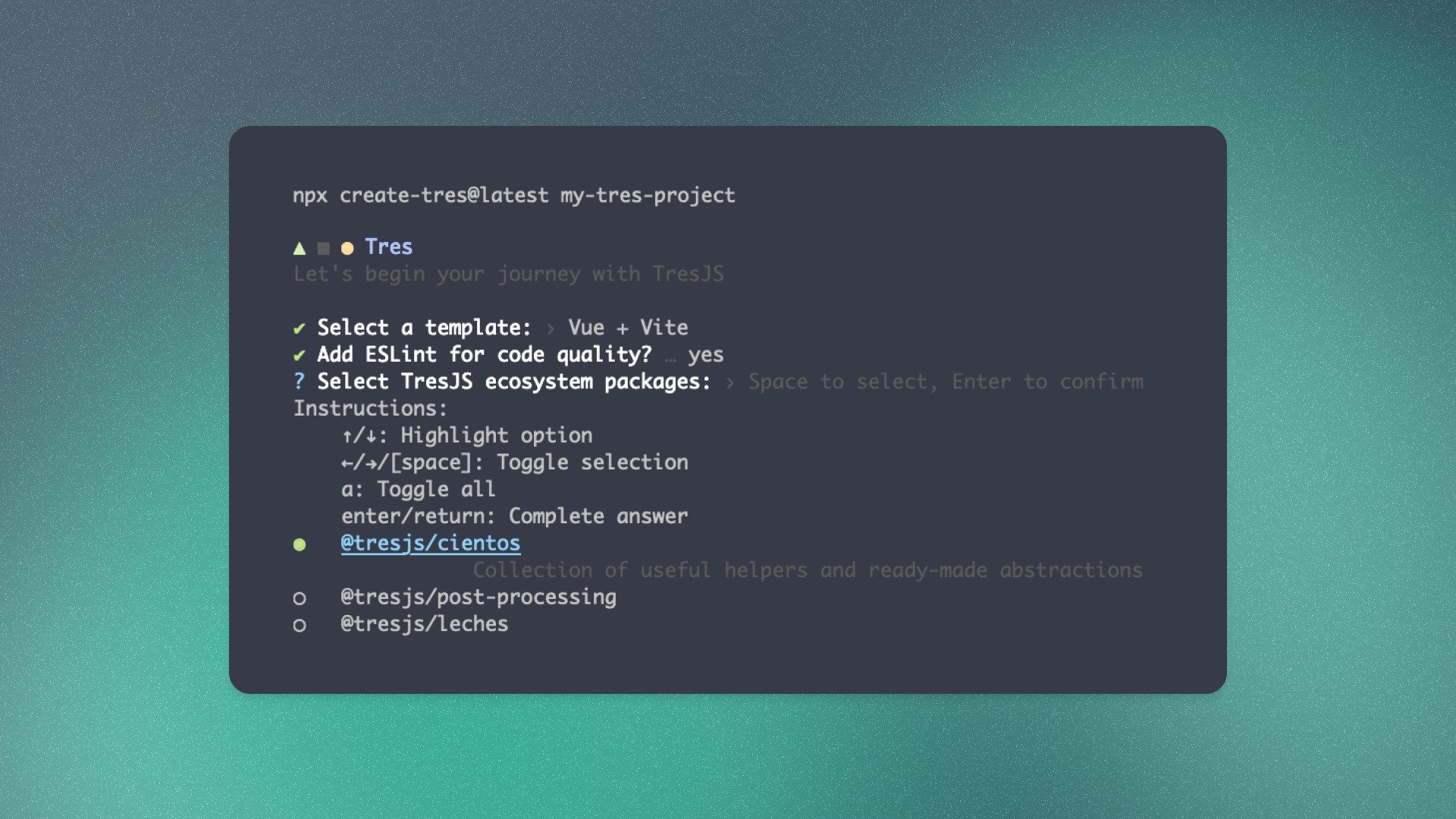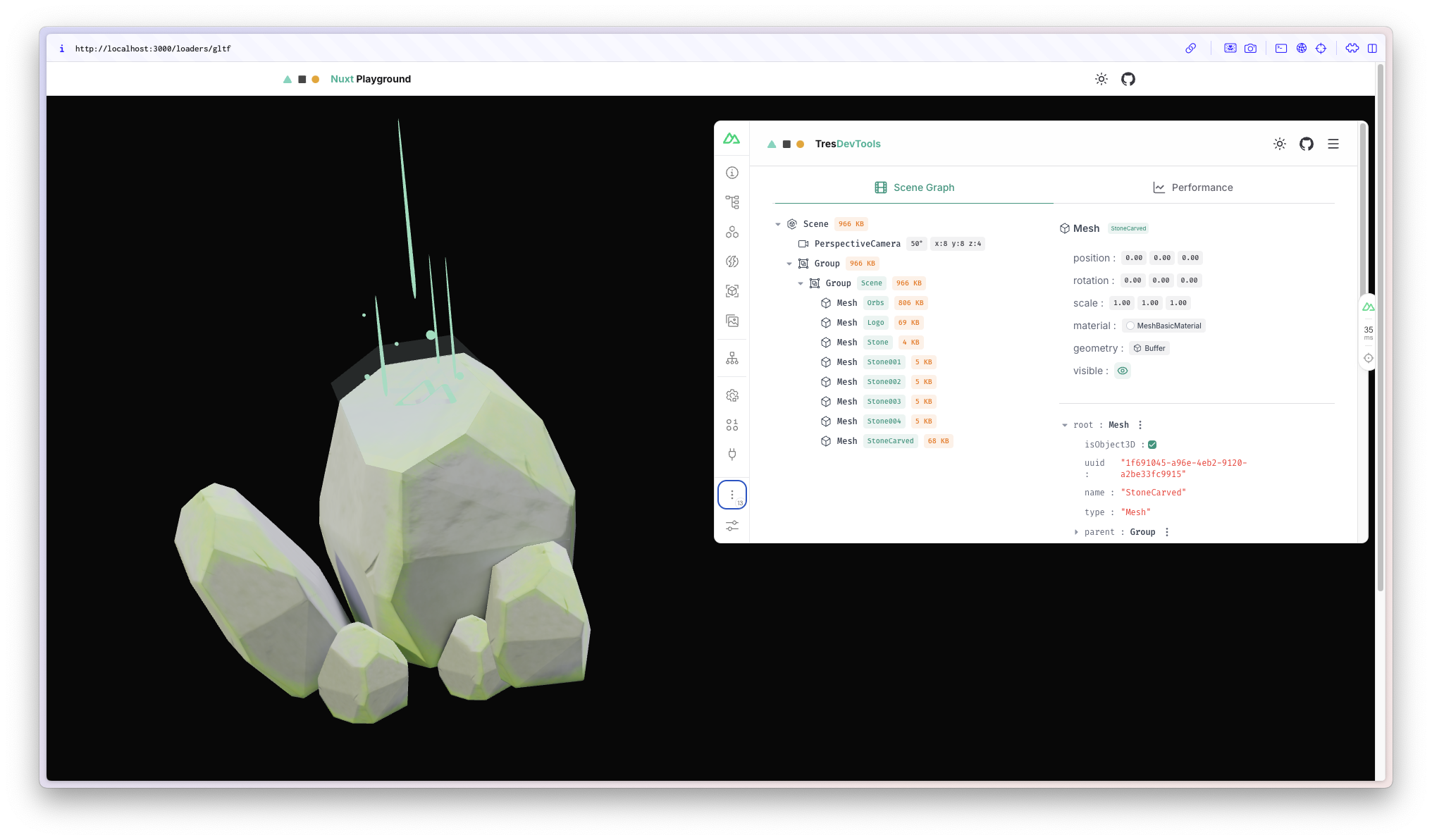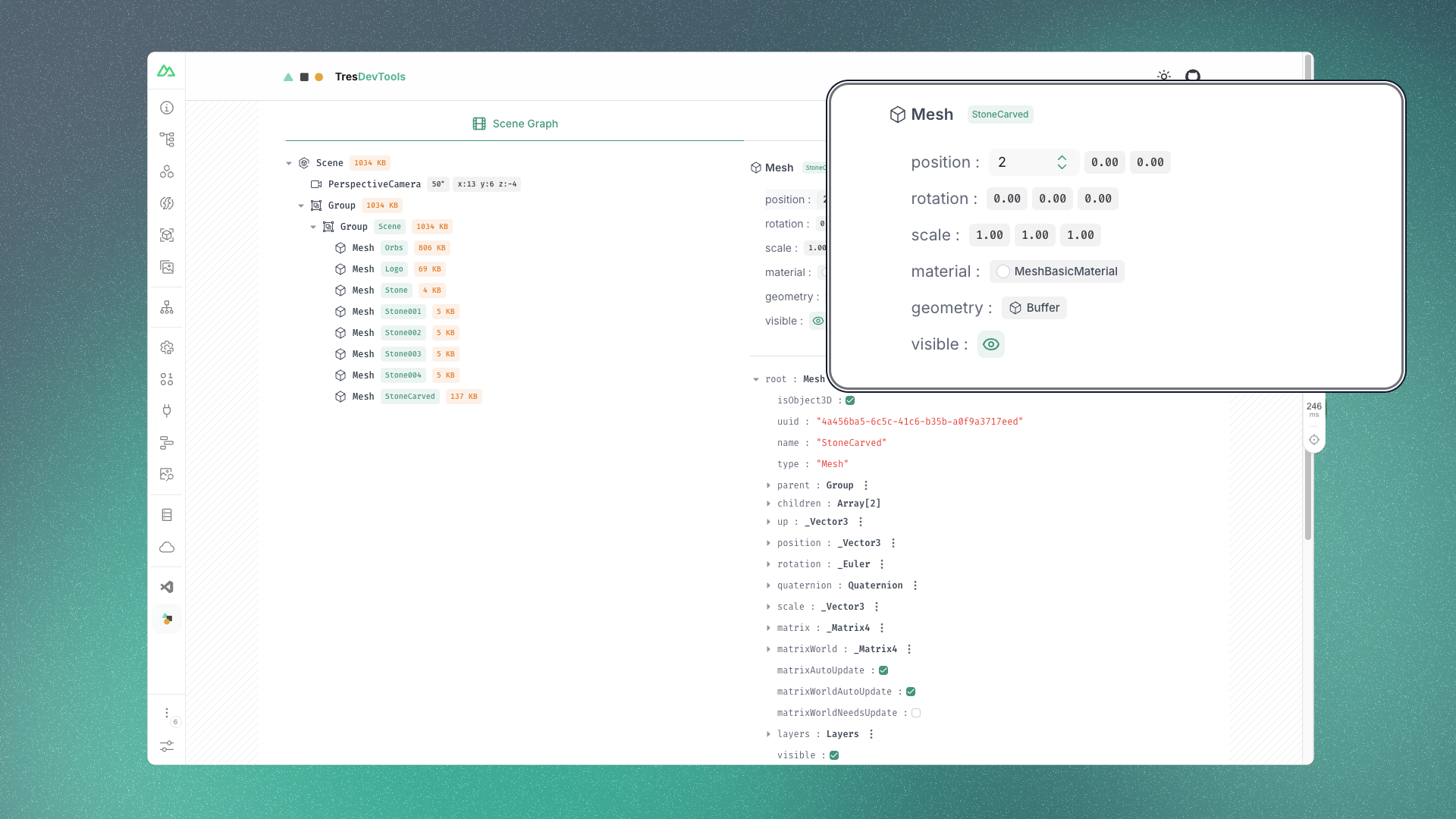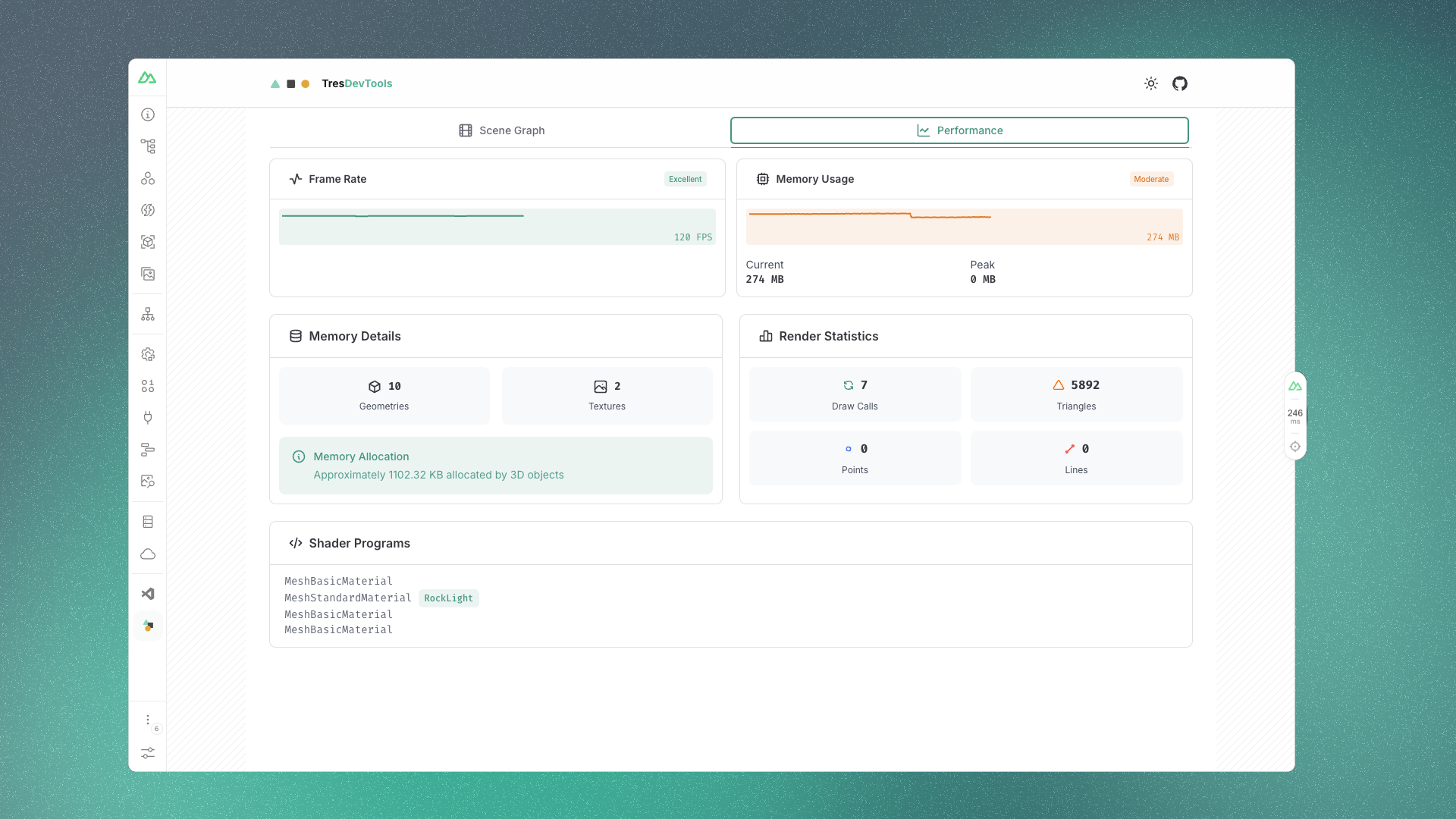Announcing Tres 5.0
Alvaro Saburido
@alvarosabu
Tino Koch
@tinoooo
After months of development since March 21st, we're thrilled to announce TresJS v5! This major release represents a significant evolution of the declarative Three.js framework for Vue, bringing modern architecture, enhanced performance, and cutting-edge WebGPU support.
🎯 What's New?
Tres 5 is our most ambitious release yet, it's all about making your developer experience better, increasing performance, and future-proofing the framework for the next generation of web graphics in Vue.
- Start a Tres project quickly: With the new
create-tresCLI tool, you can start a new Tres project in seconds. - ESM-only architecture: We've made the bold decision to embrace the future by going ESM-only.
- WebGPU native support: The future of web graphics is here! TresJS v5 introduces experimental WebGPU support
- Completely refactored composables: We've completely refactored our composables system for better reliability and type safety.
🚀 New way to start a Tres project

We've created a new CLI tool to help you scaffold a new Tres project with the best practices and the most popular packages.
npx create-tres my-tres-project
yarn create tres my-tres-project
pnpm create tres my-tres-project
The CLI provides an interactive wizard that guides you through:
- 🎯 Template selection: Choose between Vue + Vite or Nuxt
- 📦 Ecosystem packages: Select from TresJS ecosystem packages (Cientos, Post-processing, Leches)
- 🔧 TypeScript support: Type safe development with TypeScript
- 📏 ESLint integration: Code quality with TresJS ESLint config
🌟 ESM-Only Architecture
We've made the bold decision to embrace the future by going ESM-only. This means:
- Smaller bundle sizes with better tree-shaking
- Faster loading and improved performance
- Modern JavaScript standards alignment
- Better compatibility with modern build tools
⚡ WebGPU Native Support
ExperimentalThe future of web graphics is here! TresJS v5 introduces experimental WebGPU support, bringing:
- Next-generation performance for complex 3D scenes
- Better GPU utilization and compute shader support
- Future-ready architecture for upcoming web standards
- Seamless fallback to WebGL when WebGPU isn't available
<script setup lang="ts">
import { TresCanvas } from '@tresjs/core'
import { WebGPURenderer } from 'three/webgpu'
import type { TresRendererSetupContext } from '@tresjs/core'
// Create WebGPU renderer factory
const createWebGPURenderer = (ctx: TresRendererSetupContext) => {
const renderer = new WebGPURenderer({
canvas: toValue(ctx.canvas),
// WebGPU specific configuration
alpha: true,
antialias: true,
})
return renderer
}
</script>
<template>
<TresCanvas :renderer="createWebGPURenderer">
<TresPerspectiveCamera :position="[3, 3, 3]" />
<TresBoxGeometry :args="[1, 1, 1]" />
<TresMeshBasicMaterial color="hotpink" />
<!-- Your 3D scene here -->
</TresCanvas>
</template>
🔄 Enhanced Composables API
We've completely refactored our composables system to become true Vue composables (thanks to Alexander Lichter's video 😅) with proper reactive state management. The biggest motivation was that many of our previous "composables" weren't actually composables but utility functions wrapping Three.js APIs.
Completely Refactored useLoader
The useLoader composable has been transformed from a simple utility function into a true Vue composable based on useAsyncData, providing:
- Reactive state management with loading, error, and progress tracking
- Better Vue integration with proper composable patterns
- Automatic cleanup and disposal of 3D objects
- Enhanced TypeScript support and developer experience
- Dynamic path loading - change the model path reactively
<script setup>
import { GLTFLoader } from 'three/examples/jsm/loaders/GLTFLoader'
// ❌ Old v4 syntax - returned a promise
// const gltf = await useLoader(GLTFLoader, '/models/duck.gltf')
// ✅ New v5 syntax - returns reactive state object
const { state: model, isLoading, error, progress } = useLoader(
GLTFLoader,
'/models/duck.gltf'
)
// Watch for loading state changes reactively
watch(isLoading, (loading) => {
if (loading) console.log('Loading model...')
})
// Track loading progress
watch(progress, (prog) => {
console.log(`Loading: ${prog.percentage}%`)
})
</script>
<template>
<!-- Reactive loading states in template -->
<primitive v-if="model" :object="model.scene" />
</template>
Impact on Cientos Composables
This breaking change also affects Cientos composables like useGLTF and useFBX, which now follow the same reactive pattern:
<script setup>
import { useGLTF } from '@tresjs/cientos'
// ✅ New reactive state pattern in Cientos
const { state, nodes, materials, isLoading, progress } = useGLTF('/model.glb', {
draco: true
})
</script>
<template>
<primitive v-if="state" :object="state.scene" />
</template>
These Cientos composables now provide the same reactive benefits:
- Reactive loading states with
isLoadingandprogress - Structured access to
nodesandmaterialsbased onuseGraphcomposable - Consistent API across the TresJS ecosystem
Enhanced Event System
We've completely revamped the event system based on the pmndrs ecosystem standards, bringing significant improvements:
Key Changes
- New event system based on the
@pmndrs/pointer-eventspackage for battle-tested reliability - First-intersected-only behavior: Only the first intersected element will trigger pointer events, improving performance with complex scenes.
- Native DOM event names: Pointer events now follow exact DOM standards (e.g.,
@pointerdowninstead of@pointer-down). - Removed
useTresEventManager: The composable has been removed in favor of the new system.
Migration Required
Update pointer event names:
<!-- ❌ Old v4 syntax -->
<TresMesh @pointer-down="handlePointerDown">
<TresBoxGeometry />
<TresMeshBasicMaterial />
</TresMesh>
<!-- ✅ New v5 syntax -->
<TresMesh @pointerdown="handlePointerDown">
<TresBoxGeometry />
<TresMeshBasicMaterial />
</TresMesh>
Overlapping elements are handled differently:
<!-- ❌ Old behavior: multiple overlapping objects could trigger events -->
<TresMesh @click="handleClick">
<TresBoxGeometry />
<TresMeshBasicMaterial />
</TresMesh>
<TresMesh @click="handleClick"> <!-- This might not trigger if behind first mesh -->
<TresBoxGeometry />
<TresMeshBasicMaterial />
</TresMesh>
<!-- ✅ New behavior: use parent handler for overlapping elements -->
<TresGroup @click="handleGroupClick">
<TresMesh>
<TresBoxGeometry />
<TresMeshBasicMaterial />
</TresMesh>
<TresMesh>
<TresBoxGeometry />
<TresMeshBasicMaterial />
</TresMesh>
</TresGroup>
This change brings better performance, more predictable event handling, and consistency with web standards.
🛠️ Developer Experience Improvements
💔 Breaking Changes & Migration
Removed Composables
We've removed several composables that were either not true composables or have been replaced with better alternatives:
useTresReady: Use@readyevent onTresCanvasinsteaduseSeek: UseuseGraphor manual traversal functionsuseTresEventManager: Removed in favor of the new event systemuseRaycaster: Use native Three.js raycasting or the new event systemuseRenderLoop: UseuseLoopcomposable or@loopevent onTresCanvasuseLogger: Removed for simpler debugging approachuseCamera: UseuseTres()to access camerauseTexture: Moved to@tresjs/cientosfor better organization
Migration Examples
Replace useTresReady:
<!-- ❌ Old v4 syntax -->
<script setup>
const { isReady } = useTresReady()
</script>
<!-- ✅ New v5 syntax -->
<script setup>
const onReady = (context) => {
console.log('Renderer is ready:', context.renderer.instance)
}
</script>
<template>
<TresCanvas @ready="onReady">
<!-- Your 3D scene -->
</TresCanvas>
</template>
Replace useSeek:
<script setup>
// ❌ Old v4 syntax
const { seek } = useSeek()
const body = seek(car, 'name', 'Octane_Body_0')
// ✅ New v5 syntax - use useGraph
const { state: model } = useLoader(GLTFLoader, '/model.glb')
const scene = computed(() => model.value?.scene)
const { nodes } = useGraph(scene)
const body = computed(() => nodes.value?.Octane_Body_0)
</script>
Replace useRenderLoop:
<script setup>
// ❌ Old v4 syntax
const { onLoop } = useRenderLoop()
onLoop(({ delta, elapsedTime }) => {
// Animation logic
})
// ✅ New v5 syntax
const { onBeforeRender } = useLoop()
onBeforeRender(({ delta, elapsedTime }) => {
// Animation logic
})
</script>
TresCanvas Event Renaming
Update your event handlers:
<!-- Before (v4) -->
<TresCanvas
@after-render="handleAfterRender"
@before-render="handleBeforeRender"
>
<!-- After (v5) -->
<TresCanvas
@render="handleRender"
@before-loop="handleBeforeLoop"
>
Ready for Nuxt 4 with brand new devtools!
Along with TresJS v5, we're excited to announce full support for Nuxt 4, including a brand new TresJS Devtools extension for Nuxt devtools completely remade from the ground up.
npx nuxi@latest module add tresjs
pnpx nuxi@latest module add tresjs

Inspect and debug your scene
- Scene graph visualization: Explore your 3D scene hierarchy
- Real-time property editing: Modify object properties on the fly
- Copy values: Easily copy object properties for use in your code

Real-time performance monitoring
- FPS counter: Monitor your application's frame rate
- Memory usage: Keep an eye on memory consumption
- Draw calls: Analyze rendering performance

🌐 Ecosystem Updates
With v5, the entire TresJS ecosystem is evolving:
- @tresjs/cientos will receive
useTextureand other utility composables - Better modularization allows you to import only what you need
- Consistent API across all TresJS packages
🔮 Looking Forward
TresJS v5 sets the foundation for exciting future developments:
- Full WebGPU feature support as the specification stabilizes
- Enhanced compute shader integration for advanced effects
- Better Vue 3 Composition API integration with upcoming features
- Expanded ecosystem with specialized packages for different use cases
🛠️ Getting Started with v5
Ready to upgrade? Here's how:
# Update TresJS
pnpm add @tresjs/tres@latest
# Update your dependencies
pnpm add @tresjs/cientos@latest # for useTexture and other utilities
Check out our migration guide for step-by-step instructions on updating your existing projects.
🙏 Community & Contributors
TresJS v5 wouldn't be possible without our amazing community. Special thanks to everyone who provided feedback, reported issues, and contributed code during the development process.
Join our Discord community to share your v5 creations and get help with migration!
Ready to build the future of web 3D with TresJS v5? Get started today and experience the next generation of declarative Three.js development!
In the loving memory of our friend Serdar Yerdelen, we want to dedicate this release to him, the most genuine and gentle soul in our community, you will be deeply missed.
